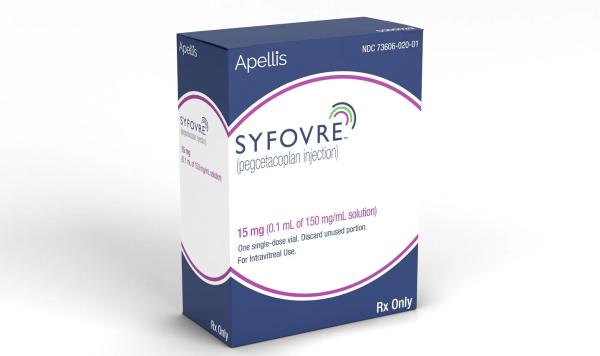Pegcetacoplan ophthalmic
Generic name: pegcetacoplan ophthalmic [ peg-SET-a-KOE-plan ]
Brand name: Syfovre
Dosage form: intravitreal solution (150 mg/mL)
Drug class: Miscellaneous ophthalmic agents
What is pegcetacoplan ophthalmic?
Pegcetacoplan ophthalmic is used to treat an eye condition called geographic atrophy in adults with age-related macular degeneration.
Pegcetacoplan ophthalmic may also be used for purposes not listed in this medication guide.
Pegcetacoplan ophthalmic side effects
Get emergency medical help if you have signs of an allergic reaction: hives, difficult breathing, swelling of your face, lips, tongue, or throat.
Some side effects may occur right after the injection. Tell your doctor right away if you have:
-
signs of eye infection--swelling, severe discomfort, crusting or drainage;
-
severe eye redness or pain;
-
eyes being more sensitive to light;
-
blurred or cloudy vision; or
-
changes in your vision, seeing flashes of light.
Common side effects of pegcetacoplan ophthalmic may include:
-
eye pain or irritation, feeling like something is in your eye;
-
an eye condition called neovascular age-related macular degeneration;
-
seeing flashes of light or "floaters" in your vision; or
-
bleeding in the white part of the eye.
This is not a complete list of side effects and others may occur. Call your doctor for medical advice about side effects. You may report side effects to FDA at 1-800-FDA-1088.
Warnings
You should not receive pegcetacoplan ophthalmic if you have swelling or infection in or around your eye.
Before taking this medicine
You should not receive pegcetacoplan ophthalmic if you have swelling or infection in or around your eye.
Tell your doctor if you have ever had:
-
increased pressure inside your eyes.
Tell your doctor if you are pregnant or plan to become pregnant. Use effective birth control while using pegcetacoplan ophthalmic and for at least 40 days after your last dose.
Ask a doctor if it is safe to breastfeed while using pegcetacoplan ophthalmic.
How is pegcetacoplan ophthalmic given?
Pegcetacoplan ophthalmic is injected in your eye. A healthcare provider will give you this injection.
Pegcetacoplan ophthalmic is given once every 25 to 60 days.
You will need frequent vision exams before and after receiving this medicine.
Pegcetacoplan ophthalmic dosing information
Usual Adult Dose for Macular Degeneration:
15 mg (0.1 mL of 150 mg/mL solution) intravitreal injection to each affected eye once every 25 to 60 days
Comments:
-Monitor the patient for elevated intraocular pressure (IOP) using tonometry before and after the intravitreal injection; if needed, ocular hypotensive medication can be given to lower the IOP.
-Administer adequate anesthesia and a broad-spectrum topical microbicide to disinfect the periocular skin, eyelid, and ocular surface prior to the injection.
-Do not use the filter needle for injection.
-Each vial should only be used for the treatment of a single eye.
Use: For the treatment of geographic atrophy (GA) secondary to age-related macular degeneration (AMD)
What happens if I miss a dose?
Call your doctor for instructions if you miss an appointment for your pegcetacoplan ophthalmic injection.
What happens if I overdose?
In a medical setting an overdose would be treated quickly.
What should I avoid while receiving pegcetacoplan ophthalmic?
pegcetacoplan ophthalmic may cause blurred vision and may impair your reactions. Avoid driving or hazardous activity until you know how this medicine will affect you.
What other drugs will affect pegcetacoplan ophthalmic?
Medicine used in the eyes is not likely to be affected by other drugs you use. But many drugs can interact. Tell your doctor about all your current medicines, including prescription and over-the-counter medicines, vitamins, and herbal products.
More about pegcetacoplan ophthalmic
- Check interactions
- Compare alternatives
- Reviews (2)
- Side effects
- Dosage information
- During pregnancy
- Drug class: miscellaneous ophthalmic agents
- Breastfeeding
- En español
Patient resources
Other brands
Professional resources
Other brands
Related treatment guides
Further information
Remember, keep this and all other medicines out of the reach of children, never share your medicines with others, and use this medication only for the indication prescribed.
Always consult your healthcare provider to ensure the information displayed on this page applies to your personal circumstances.
Copyright 1996-2024 Cerner Multum, Inc. Version: 1.01.

